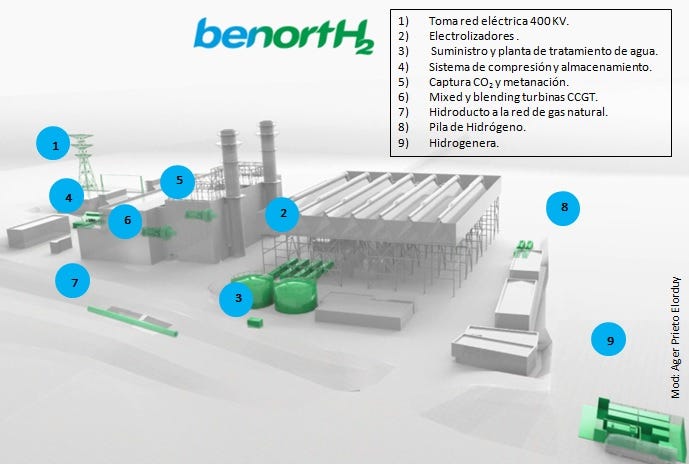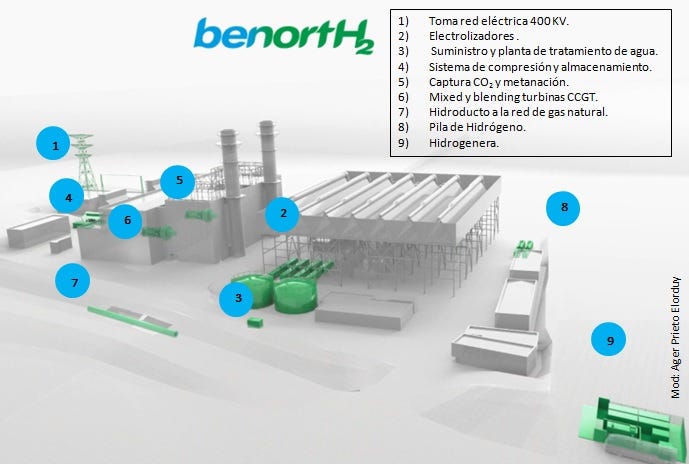10) Reconversión de planta ciclo combinado a planta de hidrógeno verde: 𝐏𝐑𝐎𝐘𝐄𝐂𝐓𝐎 𝐁𝐄𝐍𝐎𝐑𝐓𝐇𝟐
En la localidad vizcaína de Amorebieta se encuentra la planta de generación de electricidad en ciclo combinado (CCGT) propiedad de BIZKAIA ENERGIA SL, quien comenzó la explotación comercial en agosto de 2005 con una potencia nominal de 786 MW.
Dentro del ciclo combinado la generación de energía se debe a la coexistencia de 2 ciclos termodinámicos en un mismo sistema de generación. Por un lado, aprovechando la energía que genera la combustión de gas natural en 2 turbinas de gas. A su vez, la planta dispone de dos calderas de recuperación con 3 niveles de presión, y ese vapor de agua alimenta una turbina de vapor de 280 MW. Gracias al llamado Ciclo Rankine se obtienen una eficiencias del 55%, muy superiores a las que se consiguen en las centrales térmicas convencionales que rondan 35%.
El año pasado el consorcio formado por Nortegas , SENER, White Summit Capital, Castleton Commodities International y BIZKAIA ENERGIA SL anunció una medida pionera en la adaptación de instalaciones energéticas tradicionales para la descarbonización del sector. De esa manera, se convertirá una de las primeras plantas de producción de hidrogeno verde en 2022.
En la primera fase del proyecto con una inversión de 50M € y el electrolizador será de 20 MW para producir 2.000 T H₂ verde/año.
En la segunda fase que finalizará en 2030, se invertirán 250 M € para desarrollar infraestructuras con una capacidad de 200 MW alcanzando 20.000 T H₂ verde/año.
La planta estará totalmente digitalizada para su control, gestión y aplicación teórica de mejoras o modificaciones antes de su aplicación práctica. Además, se podrá escalar y replicar en otras áreas en un tiempo récord gracias al gemelo digital que utilizaran.
El proyecto contempla 4 aplicaciones para el hidrógeno renovable:
- En la propia planta para la generación de electricidad más limpia, reduciendo así emisiones de CO₂. Asimismo, el hidrógeno se utilizará para llevar a cabo la reacción de metanación y emplear ese gas natural sintético en las turbinas.
- Suministrar hidrógeno en la hidrogenera que estará ubicada en parque empresarial de Boroa para la transporte pesado de carretera (ubicación excelente por encontrarse junto a la autovía que une Bilbao - SanSebastián).
- Nortegas creará el hidroducto más largo de España (16,5km por valor de 5,1M€, donde se prevé disponer de una capacidad de 5,48 T H₂/día) para transportar el hidrógeno a las instalaciones de Enagás en Arrigorriaga y inyectándolo a la red de gas natural en el proceso conocido como blending.
- Análogamente para generar electricidad limpia se alimentará una pila de combustible con ese hidrógeno.
10) Conversion of a combined cycle plant to a green hydrogen plant: Benorth2 Project
In the Biscayan town of Amorebieta is the combined cycle electricity generation plant (CCGT) owned by BIZKAIA ENERGIA SL, which began commercial exploitation in August 2005 with a nominal power of 786 MW.
Within the combined cycle, power generation is due to the coexistence of 2 thermodynamic cycles in the same generation system. On the one hand, taking advantage of the energy generated by the combustion of natural gas in 2 gas turbines. In turn, the plant has two recovery boilers with 3 pressure levels, and this water steam feeds a 280 MW steam turbine. Thanks to the so-called Rankine Cycle, efficiencies of 55% are obtained, much higher than those achieved in conventional thermal power plants that are around 35%.
Last year the consortium formed by Nortegas, SENER, White Summit Capital, Castleton Commodities International and BIZKAIA ENERGIA SL announced a pioneering measure in the adaptation of traditional energy facilities for the decarbonisation of the sector. In this way, it will become one of the first green hydrogen production plants in 2022.
In the first phase of the project with an investment of €50M and the electrolyser will be 20 MW to produce 2,000 T H₂ green/year.
In the second phase, which will end in 2030, €250 million will be invested to develop infrastructures with a capacity of 200 MW, reaching 20,000 green T₂/year.
The plant will be fully digitized for its control, management and theoretical application of improvements or modifications before its practical application. In addition, it can be scaled and replicated in other areas in record time thanks to the digital twin that they will use.
The project contemplates 4 applications for renewable hydrogen:
- At the plant itself for the generation of cleaner electricity, thus reducing CO₂ emissions. Likewise, hydrogen will be used to carry out the methanation reaction and use that synthetic natural gas in the turbines.
- Supply hydrogen in the hydrogen plant that will be located in the Boroa business park for heavy road transport (excellent location as it is next to the highway that connects Bilbao - San Sebastián).
- Nortegas will create the longest hydroduct in Spain (16.5km for a value of €5.1M, where it is expected to have a capacity of 5.48 T H₂/day) to transport the hydrogen to the Enagás facilities in Arrigorriaga and inject it to the natural gas network in the process known as blending.
- Similarly, to generate clean electricity, a fuel cell will be fed with that hydrogen.






